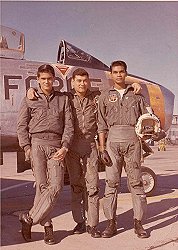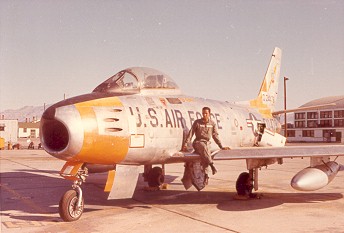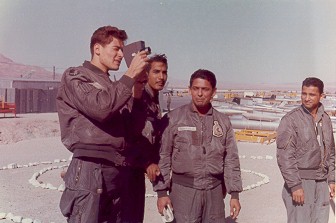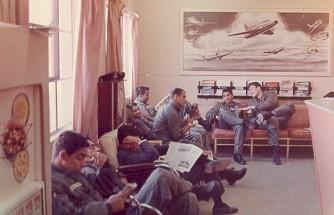The following are the IAF Fighter Boys who flew Sabre jets in the USAF with the 21st Tiger Squadron, Nellis AFB, between September 1963 and June 1964.
Where are they now?
Vinod Kumar “Jimmy” Bhatia PVSM AVSM VrC & Bar ADC (India) (Retired AOC-in-C WAC)
Darshan Singh Brar (Sydney, Australia)
“Naughty” Nautyal (USA)
Boman Irani (India)
“Dinky” Jatar (RIP – passed away 2001)
Arun Jatar (Left IAF – lost contact in 1964)
“Kakles” A. Kale (Sydney, Australia)
A. K. Kaushal (RIP – Gnat crash in 1964 @ Ambala)
“Chimp” Potnis (RIP – Gnat crash in 1965)
S. S. “Dangerman” Dange (India)
“Petros” Peter Michael Brown (Sydney, Australia)
Michael McMahon (retired VCAS, Bangalore, India)
Russel Montes (Adelaide, Australia)
Philip Rajkumar (retired , Bangalore, India)
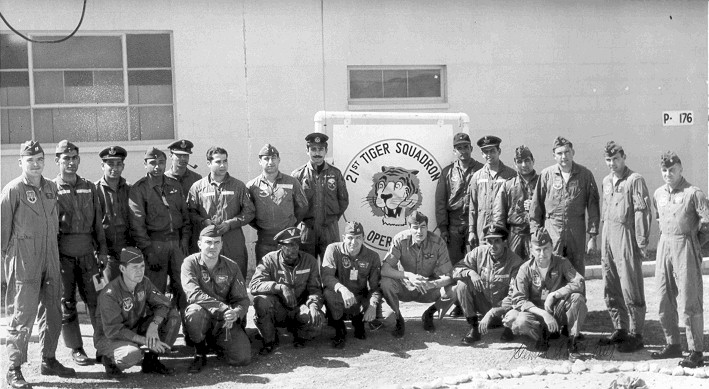 |
| At the 21st Tiger Sqn Nellis AFB Nevada
Standing L to R : Capt. Koklebeck (USAF), Fg Offr Kaushall, Flt Lt “Chimp” Potnis, Fg Offr Bobby Roy, Fg Offr Nautiyal, 1st Lieut. Guvera (Venezulian AF), 1st Lieut Vossou (Iranian AF), Plt Offr Shah (PAF), Fg Offr J S Brar, Fg Offr A N ‘Kakles’ Kale, 1st Lieut from Iranian AF, Capt Philip “Jack” Morris (USAF), Capt from USAF, Major Brown (USAF) Sitting L to R: Capt from USAF, Capt Grandchap (USAF), 1st Lieut H Salesse (Ethopian AF), Capt Stein (USAF), Plt Offr Peter Brown, Plt Offr SS Dange, Capt Dennis Elkins (USAF) |
The above named were the first two batches of IAF Fighter Jocks sent by the Bharatiya Vayu Sena in November 1963 to the USA to fly with the USAF. The visit of IAF Fighter Pilots to the USA was occasioned by invitation of the Secretary of Defence of the USA. At that time, November 1963, Kenneth Galbraith was the US Ambassador to India and had just sponsored the United States Military Supply Mission India (USMSMI) initiative. This initiative, I believe, was a follow on from the 1962 Chinese military incursion into NEFA, Sikkim and Ladakh. A military show of strength with the presence of the US Navy Fleet in the Bay of Bengal and an Air exercise called “Shiksha” was brought together. Fighter and Bomber units from the USAF, RAF and the IAF engaged in War simulation activities along the northern ring of bases from Baghdogra and Kalaikunda in the east to Pathankot in the west.
The two batches trickled into the USA on USAF Military Air Transport Service (MATS) KC-135 Boeing transports that were configured with the seats facing the tail section. En-route, landings were made at Bangkok, Saigon and Clark AFB outside Manila. There are many tales to be told of sorties in these cities, but not now. I use the word “trickled” because we traveled on different dates from October 1963 onwards in three sections. I was earmarked to travel to the USA on the 26 November together with Chimp Potnis and Dange, However, things didn’t go as planned, read on. In the early hours of the 23rd (Nov) morning while we (Chimp, Dange and self) were on a “Search & Destroy” mission that had started at Laguna’s on Janpat the evening before, continued thru to Claridges Hotel and ended up at the Central Vista Mess at about 1 am on the 23rd Nov., we received some staggering news.
On arriving at our quarters at the CV Mess we bumped into Kersi Gandhi (42 Sqn Otters), who had the latest newspaper “Hot off the Press” with headlines splashed across the front page, “US President Kennedy Assassinated”. I have never ever witnessed a bunch of Pilots go from a state of careless inebriation to one of wondering soberness in a matter of seconds, as I did that fateful day. Our thoughts and words were full of themes such as “Whodunit”, “Was it the Russians? Castro?” “What will become of our trip?”, till our energies were exhausted and we drifted off into the peacefulness of a well deserved and alcohol induced sleep.
The assassination of President Kennedy on the 22 November had the effect of delaying our departure for the USA till the 6th December. Those who had left in October and early November were sent to a language school at Lackland AFB in Texas. The guys must have been great actors for it took the authorities at the language school at Lackland about four weeks to determine that the pilots from India were fluent in English. By the time Chimp, Dange and self, landed up at Lackland AFB, we were processed straight to Randolph AFB, about 30 miles outside San Antonio Texas. We were scheduled to commence flying the T-33 Trainer (also called the T-Bird) along with the earlier Bharat crew who were by now fluent in English.
Flying from Randolph was quite enjoyable. It was winter in Texas and snow covered the ground and most of the countryside. The T-Bird was a great Trainer with tandem seating for the instructor and trainee pilot. It was a straight wing jet with the performance similar to the Vampire and massive 230-gallon drop tanks on the wing tips. Could fly for ages and the radio navigation-aids (VOR and TACAN) were pretty sophisticated, and so we weren’t too worried about loosing our way in the snow-covered countryside. The most memorable things about our sojourn at Randolph AFB were: the Officer’s Club, eating Tacos, Enchiladas and Chili-Corn-Carne in downtown San Antonio, visiting the Alamo and listening to “Black Jazz Musicians” at a dive within a stones throw of the Alamo. Others might say that the lovely Spanish American Senioritas were more memorable than all else.
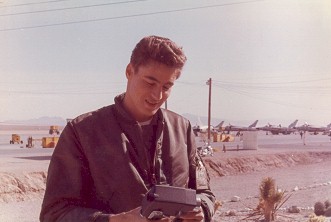 |
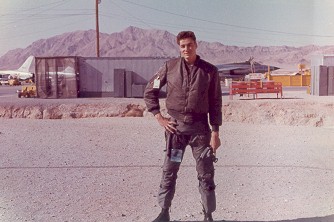 |
| Pilot Officer Peter Brown at Nellis Air Force Base during his deputation to the USAF in 1963. | |
Personally I found the sight and sound of a Talon T-38 taking off with its nose pointed up at angle of 45 degrees the most exciting experience at Randolph AFB. In 1963 the Talon T-38 held the fastest climb to height record of any fighter in the USAF.
After four weeks at Randolph, we had become somewhat acclimatised to the cold, had developed an acceptance of the high calorie food and enjoyed the generous hospitality of the lovely Spanish American and Mexican ladies of San Antonio. It made one feel that the defeat of the Americans by the Mexican General at the battle for the Alamo had its benefits, albeit about a century later.
It was the first week of January and we were on a civil flight out of San Antonio heading for Las Vegas with a re-fueling stop at Phoenix Arizona. It was while we were waiting at the Phoenix Terminal for our onward flight to Vegas, that we heard “Spanish Eyes” sung for the first time over the radio and memories of the Senioritas we had left behind in San Antonio came flooding back to haunt us. The other memorable thing about Phoenix was that every home we saw while circling to land had a swimming pool.
Plt Offr J L “Brother” Bhargava with a F-86 Sabre of the USAF .
Well! Landing at Vegas was an experience one never forgets. The walkway from the plane to the heart of the Terminal building was paved on either side with “One Arm Bandits” (slot machines). By the time we had arrived at the desk where we were to be picked up and driven to Nellis AFB, I had won a jackpot of 1$ silver coins that was a windfall that saw us through many enjoyable nights at the various shows in town.
Our introduction to the American Pilot Instructors of the 21st TIGER Squadron was perhaps one of the first social events we experienced and one that will always stand out as an example of how cosmopolitan we Indians were back in the 1960s.
Potnis, Dange and self were invited for a drink to the Officer’s Club (equivalent of the Officer’s Mess). Major ‘Bolo’ Brown, who was the 21st TIGER Squadron Commander, did the introductions as follows.
“Captain Potnis, Indian Air Force.”
I could see some doubts on the faces of the American Instructors. It appeared that they were thinking, “Indian? He looks like a Mexican!”
“1st Lieutenant Dange, Indian Air Force.”
I noticed the same look of wonderment on the faces of the American Instructors. Their expressions seem to say, “Too tall, thought Indians were short black fellas.”
“2nd Lieutenant Brown, Indian Air Force.”
Captain Marston, one of the American Instructors called out, “Hi Lieutenant, how long have you been attached to the Indian Air Force?”
“All my flying life except for the last 5 weeks.” I replied.
“Hell!” cried Marston, “didn’t know Americans could fly with the Indian Air Force.” This was a real icebreaker, as the whole group broke out laughing leaving us Indians to savor this moment of acceptance, American style.
It was this sort of informality that was the hallmark of the American character and led to a greater understanding of the way they approached their relationships with other officers and men of the service.
Having broken through the ‘social barrier’ it was now time to go for the ‘sound barrier’. One of the first missions on the F-86F Sabre Jet was a solo ‘Handling and Air Combat Maneuvers (ACMs)’ sortie. During this mission I was flying over the Grand Canyon at a height of 40,000 feet. I had completed a series of hard turns and needed to loose height to about 20,000 feet to commence some ACMs. To accomplish this, I put the Sabre Jet into a 45 Degree dive, as the altimeter unwound at a high rate of knots, and the Mach meter started registering about .8M.
On going thru 32,000 feet the Mach was up to .95 and the right wing began to drop. Tried holding off the right bank with aileron and rudder, but with no luck, the Sabre Jet was now in a 60 Degree bank as the Mach registered 1.0. It was now time to pull up and level out. The Altimeter read 24,000 as I drew the Sabre jet level with the horizon the Mach stabilized at .9M. This experience was key in understanding the Sabre Jets handling capability at high speed. What this showed us IAF pilots was that the Sabre Jet was not as stable as the Mystere, Hunter or Gnat at speed in excess of .95M. As the ACM sortie progressed it also became evident that the Sabre Jet had a very tight turning radius. The Yanks were right in claiming that the Sabre Jet could ‘turn on a Dime!’ The automatic leading edge slats of the Sabre Jet made it a formidable air combat fighter that had superiority if engaged in horizontal scissor maneuvers. The Hunters and Gnats on the other hand, had a better ‘power weight’ ratio and had superiority in vertical scissor maneuvers. This was a lesson dearly learnt by those who had not experienced flying the Sabre Jet, during the 65 Ops.
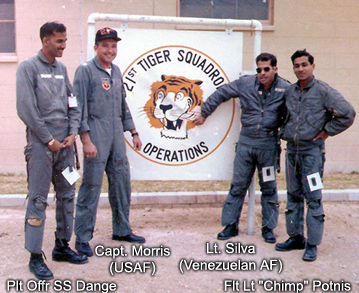 |
| Plt Offr SS Dange, Capt Philip “Jack” Morris USAF, Lt Silva (Venezuela) and Flt Lt “Chimp” Potnis. Photo Courtesy : John Rhodes |
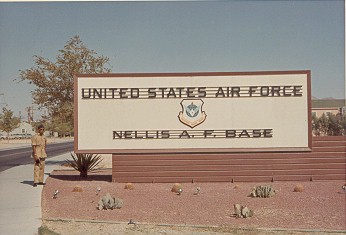
Plt Offr Philip Rajkumar at the Nellis AFB entrance
The period January 1964 through to June 1964 was a time of flying exhilaration as the 21st Tigers commenced Air-to-Ground and Air-to-Air gunnery sorties. The Sabre Jet was armed with four .50 caliber guns, two on either side of the nose, below the cockpit. It also could carry two 1,000 pound HE or Napalm bombs.
The gunnery missions were carried out on a dry lakebed some 60 miles out side Vegas on the far side of Mt. Charleston (Charlie). The Air-to-Ground mission types were, Front Guns, Dive Bombing and Skip Bombing. The Air-to-Air missions were flown in a pattern where two Sabre Jets in sequence performed a roll-in 30 Degree angle off attack commencing 1,500 feet above and line abreast with the target Banner being towed by a T-33 trainer. The rule was that break-off had to occur at a minimum distance of 300 feet and a minimum angle off of 10 Degrees. If this rule was broken then the attack pilot risked the Banner being released literally in their faces! The competition was severe. Pilots from various Nations including; Spain, Nicaragua, Chile, Nationalist China (Taiwan), Burma, Vietnam, Pakistan, Ethiopia and Iran competed in these missions that were split into two batches. After five months of intensive flying the IAF proved unbeatable and won all the gunnery trophies with the Top Gun Honours being won by Jimmy Bhatia (1st batch) and J S Brar (2nd batch). These victories recognised the high standard of flying and gunnery training imparted to IAF pilots in the Indian Defence Forces in the 1960s. It is interesting to note that the pilots from the other nations had their jet training in the US Flying Academy.
I believe there were two other batches of IAF pilots that were sent to the US to fly with the 21st Tiger Squadron. Michael Mc Mahon, who is now AOC-in-C South Western Air Command based at Gandhinagar, was a member of one of these batches and may have some stories to tell.
Flt Lt Peter Brown was commissioned into the Indian Air Force with the 83rd Pilots Course from Hakimpet on 9th March 1963. He was one of the first Indian pilots to be deputed to the United States of America for training on the F-86F Sabres. After flying Mysteres, Vampires, Hunters, he retired from the IAF in 1967 and migrated to Australia.
